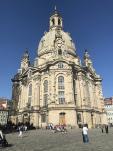 75 years ago tonight Allied bombers destroyed nearly 90% of buildings in the German city of Dresden, killing around 25,000 people. Dresden became synonymous with death by firestorm. I have spoken with people who were there and survived.
75 years ago tonight Allied bombers destroyed nearly 90% of buildings in the German city of Dresden, killing around 25,000 people. Dresden became synonymous with death by firestorm. I have spoken with people who were there and survived.
This is the text of an article published today in the Yorkshire Post to mark the anniversary.
Several years ago I stood in the pulpit of the Frauenkirche in Dresden and addressed an audience of 1200 Germans. It was a poignant moment for me. My parents had endured bombing by German aircraft over Liverpool from 1941 and I was familiar with the stories of destruction, death and fear. But,here I was, in an iconic German church in a different world, but with the scars of war all around me.
Let me put this in context. That same morning I had preached in Meissen Cathedral and had shaken hands with several hundred people as they left the service. The last man to leave refused to shake my hand. When I asked why, I was told that “I come from Dresden and what you did there was a war crime”. I replied that (a) I didn’t do it, and (b) no one wins in war … as my parents could confirm. After a silence he extended his hand. He was in the congregation in the Frauenkirche later that afternoon.
The event he described as a ‘war crime’ was the bombing of Dresden during the night of 13/14 February 1945 which caused a massive firestorm, the destruction of the historic city and the deaths of thousands of people. Allied bombers flew in waves and the cumulative effect of the bombing of the civilian population was devastating.
Of course, Dresden wasn’t the only city to be targeted in this way by the Allies. Arguments have continued to rage ever since as to whether there is some moral culpability – whether it was, in fact, a war crime – that has yet to be acknowledged. Should civilians have been deliberately attacked in this way?
Well, moral culpability in war is not an easy or straightforward matter. One German friend of mine, an academic theologian, wondered why I was spending time thinking about this: “We started it,” she said, “and have few grounds for complaint about what was done to us.” Not everyone agrees.

Frauenkirche, Dresden, with Pfarrer Sebastian Feydt
The Frauenkirche was almost totally destroyed during the attack of 13/14 February. It stood as a ruin in the center of the old city until the fall of the Berlin Wall in 1989 and German reunification in 1990. Local citizens were asked what they would like restored first and their answer was unequivocal: rebuild the Frauenkirche, the symbol of spiritual and moral repentance, resilience, and hope. Reconstruction was completed in 2005 and I first visited it in 2009.
But this was not some nostalgic, overly-sentimentalised restoration. If you stand in the pulpit of the beautifully restored building to lead worship or speak to the congregation, they are looking past you to the Baroque altar. What they see is the original altar restored with new stone and carving, but with original scorched and blackened stones integrated into it. In other words, their eyes are confronted with that shattering remembering: that renewal cannot escape a coming to terms with the past. Healing involves confronting the guilt and the pain of past agonies – received from or inflicted on others – and not trying to whitewash a common moral responsibility.
Dresden has now been almost completely restored to its pre-war glory. Which is a little weird. Like Warsaw and some other destroyed cities, they have been rebuilt to look exactly as they did before the bombing. Rather than build something new, they went back to what was there before. I am not a psychologist, but this must be interesting for those who are. Is it a way of trying to imagine that the Weimar Republic and Third Reich had never happened? Or does it represent a determination to remember a golden age (as if there was ever such a thing), the memory of which reassures them that there was something good in their culture in the past?
This is complex stuff. What I have always encountered in Christians in Dresden – and I have good friends there – is a courageous commitment to face the past, but move on in the light of it. The Frauenkirche stands as a symbol of that commitment. At the heart of the city, the scorch marks in its very fabric cry out with the pain of lost lives and lost decades whilst beckoning us to not repeat the crimes of an earlier time. The black streaks in pale stone confront us with what happens when power lies in the hands of liars and charlatans who see other people as commodities to be traded or extinguished.
But, the wounds also speak of forgiveness and reconciliation. The scars – like those in the hands and side and feet of the risen Jesus Christ – don’t romanticise the pain, but whisper that pain and death do not have the last word. Reconciliation is possible. Healing is not impossible.
It will be interesting to see what role this church plays as Far Right political movements, founded here in Dresden, gain traction amongst the populace. Do we ever learn from history? Perhaps the Frauenkirche might continue to stand as a challenge to sloganizing populism of the sort that, in the hands of those powermongers who exploit chaos and fear, quickly slides from indifference or selfishness to a dehumanising cruelty.
